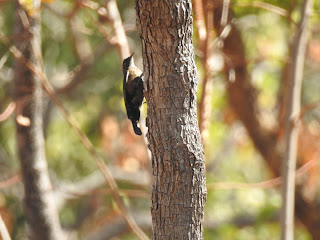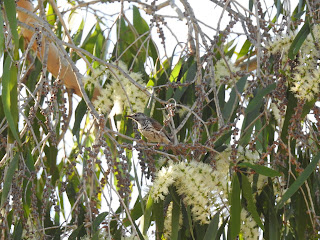The horrid droughts up north of Victoria drove a wide variety of species further south than usual earlier this year. Most significantly, there was a massive state-wide irruption of Crimson Chats, a species that is normally impossible to see without going interstate. Originally I didn't think I'd be able to track any of the chats down, as at first they seemed to only be present in large numbers in the mallee of far north Victoria, which would have required an overnight trip that I thought would be impossible to justify in Year 12.
However, chat sightings then began to pop up from a site in Bendigo, White Hills Chinese Diggings Reserv. This was only about 2 hours drive away from home. Hence, I figured I could head out early in the morning, twitch the chats and then get back with enough time left in the day to study. Somehow I was able to convince my dad that this was a good idea.
And so in the middle of the term 3 holidays we left home at about 6 in the morning, arriving in the diggings reserve a little after 8.
After having some trouble finding the entrance of the place, we managed to discover a short and rather unimpressive trail leading into some woodland. Here I initially saw very little of note, with only New Holland honeyeaters and a few white-browed scrubwrens present. I noticed the main bird of note here about halfway down the trail: a male rufous songlark singing from atop a bush, a species that has been more widespread in Victoria this year than usual.
We noticed that the woodland seemed to continue a bit further to the left, so we made our way through the undergrowth. Here the area was swarming with white-winged trillers, another spring migrant that came down south in unexpectedly high numbers this year.
WHITE-WINGED TRILLER
As we continued walking, we met a few other birders. At first their reports that they hadn't seen the chat yet put a dent in my spirits, and I was fairly sure this trip was going to be yet another case of me travelling an unholy distance purely to dip on my target. Then someone with sharper eyes than I spotted a small, bright red bird moving between two bushes: a male chat! We moved towards it and first found a small party of immature crimson chats, before getting crippling views of several brilliantly coloured males. I could not have asked for more.
CRIMSON CHAT
CRIMSON CHAT (immature)
To add icing on the cake, a rather fearless brown-headed honeyeater flew past me and landed in a nearby tree as I was watching the chats, giving me the best views of the species I've had to date, although the lighting wasn't good enough for any particularly good photos. A breeding pair of white-backed swallows were also making circuits of the area, and as we left the site one flew right past me, giving me a good look at it. Though we were unable to see the black honeyeaters that had previously been spotted at the site, we still left thrilled with our success.
BROWN-HEADED HONEYEATER
At this point in time, although the trillers and songlarks continue to be unusually common throughout Victoria, the irruption of chats has mostly ended, so I am glad I was able to twitch them while they were still around. For any other hopeful readers, I believe a few birds are still hanging around Lake Tyrell.






























































